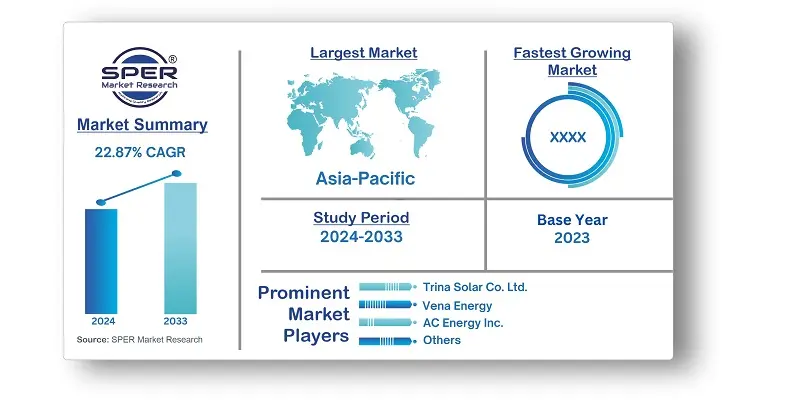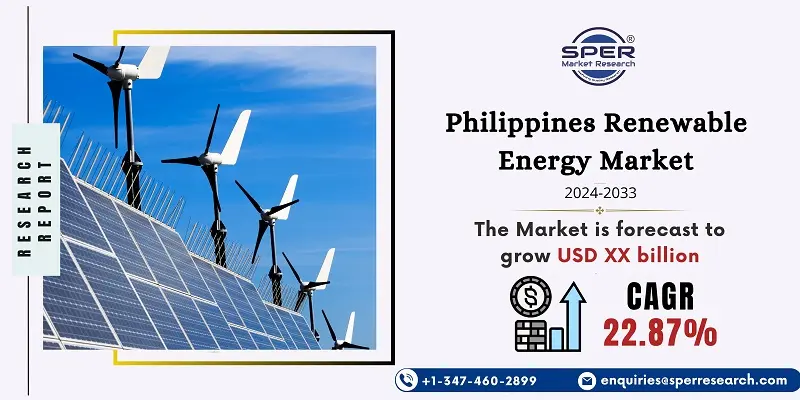
Philippines Renewable Energy Market Growth, Size, Trends, Share, Revenue and Future Outlook
Philippines Renewable Energy Market Size- By Type- Regional Outlook, Competitive Strategies and Segment Forecast to 2033
| Published: Aug-2024 | Report ID: POAE2479 | Pages: 1 - 105 | Formats*: |
| Category : Power & Energy | |||
- November 2023: Development rights for a 160 MW wind farm in the Philippines have been given to ACCIONA EnergÃa and its local partner Freya Renewables. Through its fourth Open and Competitive Selection Process (OCSP4) for hydropower, geothermal, and wind energy resources, the Philippine Department of Energy (DOE) has awarded the contract.
- In September 2022, Olympia Violago Water and Power (OVWPI), a developer of renewable energy, stated that Ahunan Power will purchase the bulk of its shares. The rights to create a 500 MW pumped hydro storage facility are owned by this corporation.


| Report Metric | Details |
| Market size available for years | 2020-2033 |
| Base year considered | 2023 |
| Forecast period | 2024-2033 |
| Segments covered | By Type |
| Regions covered | Eastern Region, Western Region, Southern Region, Northern Region. |
| Companies Covered | Aboitiz Power Corporation, AC Energy Inc., Alternergy Philippine Holding Corp., National Power Corporation, Philippine Geothermal Production Company Inc., Solar Philippines Power Projects Holdings Inc., Solaric Corp., Solenergy Systems Inc., Trina Solar Co. Ltd., Vena Energy, Vestas Wind Systems AS, Others. |
- Government Agencies
- Energy Investors and Financial Institutions
- Renewable Energy Companies
- Environmental NGOs and Advocacy Groups
- Corporate Energy Buyers
- Utility Companies
- Research and Development Institutions
- Policy Makers and Regulators
| By Type: |
|
- Philippines Renewable Energy Market Size (FY’2024-FY’2033)
- Overview of Philippines Renewable Energy Market
- Segmentation of Philippines Renewable Energy Market By Type (Solar, Wind, Hydro, Others)
- Expansion Analysis of Philippines Renewable Energy Market
- Problems and Obstacles in Philippines Renewable Energy Market
- Competitive Landscape in the Philippines Renewable Energy Market
- Impact of COVID-19 and Demonetization on Philippines Renewable Energy Market
- Details on Current Investment in Philippines Renewable Energy Market
- Competitive Analysis of Philippines Renewable Energy Market
- Prominent Players in the Philippines Renewable Energy Market
- SWOT Analysis of Philippines Renewable Energy Market
- Philippines Renewable Energy Market Future Outlook and Projections (FY’2024-FY’2033)
- Recommendations from Analyst
1.1. Scope of the report1.2. Market segment analysis
2.1. Research data source
2.1.1. Secondary Data2.1.2. Primary Data2.1.3. SPER’s internal database2.1.4. Premium insight from KOL’s
2.2. Market size estimation
2.2.1. Top-down and Bottom-up approach
2.3. Data triangulation
4.1. Driver, Restraint, Opportunity and Challenges analysis
4.1.1. Drivers4.1.2. Restraints4.1.3. Opportunities4.1.4. Challenges
4.2. COVID-19 Impacts of the Philippines Renewable Energy Market
5.1. SWOT Analysis
5.1.1. Strengths5.1.2. Weaknesses5.1.3. Opportunities5.1.4. Threats
5.2. PESTEL Analysis
5.2.1. Political Landscape5.2.2. Economic Landscape5.2.3. Social Landscape5.2.4. Technological Landscape5.2.5. Environmental Landscape5.2.6. Legal Landscape
5.3. PORTER’s Five Forces
5.3.1. Bargaining power of suppliers5.3.2. Bargaining power of buyers5.3.3. Threat of Substitute5.3.4. Threat of new entrant5.3.5. Competitive rivalry
5.4. Heat Map Analysis
6.1. Philippines Renewable Energy Market Manufacturing Base Distribution, Sales Area, Product Type6.2. Mergers & Acquisitions, Partnerships, Product Launch, and Collaboration in Philippines Renewable Energy Market
7.1. Philippines Renewable Energy Market Size, Share and Forecast, By Type, 2020-20267.2. Philippines Renewable Energy Market Size, Share and Forecast, By Type, 2027-20337.3. Solar7.4. Wind7.5. Hydro7.6. Others
8.1. Philippines Renewable Energy Market Size and Market Share
9.1. Philippines Renewable Energy Market Size and Market Share By Region (2020-2026)9.2. Philippines Renewable Energy Market Size and Market Share By Region (2027-2033)9.3. Eastern Region9.4. Western Region9.5. Northern Region9.6. Southern Region
10.1. Aboitiz Power Corporation
10.1.1. Company details10.1.2. Financial outlook10.1.3. Product summary10.1.4. Recent developments
10.2. AC Energy Inc.
10.2.1. Company details10.2.2. Financial outlook10.2.3. Product summary10.2.4. Recent developments
10.3. Alternergy Philippine Holding Corp.
10.3.1. Company details10.3.2. Financial outlook10.3.3. Product summary10.3.4. Recent developments
10.4. National Power Corporation
10.4.1. Company details10.4.2. Financial outlook10.4.3. Product summary10.4.4. Recent developments
10.5. Philippine Geothermal Production Company Inc.
10.5.1. Company details10.5.2. Financial outlook10.5.3. Product summary10.5.4. Recent developments
10.6. Solar Philippines Power Projects Holdings Inc.
10.6.1. Company details10.6.2. Financial outlook10.6.3. Product summary10.6.4. Recent developments
10.7. Solaric Corp.
10.7.1. Company details10.7.2. Financial outlook10.7.3. Product summary10.7.4. Recent developments
10.8. Solenergy Systems Inc.
10.8.1. Company details10.8.2. Financial outlook10.8.3. Product summary10.8.4. Recent developments
10.9. Trina Solar Co. Ltd.
10.9.1. Company details10.9.2. Financial outlook10.9.3. Product summary10.9.4. Recent developments
10.10. Vena Energy
10.10.1. Company details10.10.2. Financial outlook10.10.3. Product summary10.10.4. Recent developments
10.11. Vestas Wind Systems AS
10.11.1. Company details10.11.2. Financial outlook10.11.3. Product summary10.11.4. Recent developments
10.12. Others
SPER Market Research’s methodology uses great emphasis on primary research to ensure that the market intelligence insights are up to date, reliable and accurate. Primary interviews are done with players involved in each phase of a supply chain to analyze the market forecasting. The secondary research method is used to help you fully understand how the future markets and the spending patterns look likes.
The report is based on in-depth qualitative and quantitative analysis of the Product Market. The quantitative analysis involves the application of various projection and sampling techniques. The qualitative analysis involves primary interviews, surveys, and vendor briefings. The data gathered as a result of these processes are validated through experts opinion. Our research methodology entails an ideal mixture of primary and secondary initiatives.



Frequently Asked Questions About This Report
PLACE AN ORDER
Year End Discount
Sample Report
Pre-Purchase Inquiry
NEED CUSTOMIZATION?
Request CustomizationCALL OR EMAIL US
100% Secure Payment






Related Reports
Our Global Clients
Our data-driven insights have influenced the strategy of 200+ reputed companies across the globe.






















